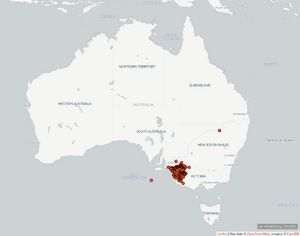Silky mouse facts for kids
Quick facts for kids Silky mouse |
|
|---|---|
| Conservation status | |
| Scientific classification | |
| Genus: |
Pseudomys
|
| Species: |
apodemoides
|
The silky mouse (Pseudomys apodemoides) is a small rodent that lives only in Australia. It's known for its soft fur, which gives it its name. These tiny creatures are part of the Muridae family, which includes many types of mice and rats.
Contents
What Does the Silky Mouse Look Like?
Silky mice are quite small. Their body and head together are usually about 65 to 80 millimeters long. Their tail is even longer, measuring between 90 and 110 millimeters. They weigh about 16 to 22 grams, which is about the same as a few quarters. They have light brown and gray fur on their backs, and their bellies are covered in white fur.
Where Do Silky Mice Live?
Silky mice are found only in south-eastern Australia, especially in western Victoria. They like to live in sandy areas called heathlands. These areas have many different plants like banksias, tea-trees, broombush, and mallee eucalypts. Silky mice use these plants to hide the entrances to their homes.
Their Underground Homes
These mice are expert diggers! They create complex burrows underground. These burrows are about 2 centimeters wide and have many tunnels and rooms. They need a lot of different plants in their habitat. This is because they eat mostly plants, and they need plants that grow and produce fruit all year long. Silky mice don't do well in very hot weather or when there isn't enough water.
Behavior and Life Cycle
Silky mice are nocturnal, which means they are active at night. During the day, they rest safely in their burrows. When night comes, they go out to search for food.
What Do Silky Mice Eat?
Silky mice are mainly herbivores, meaning they eat plants. Their diet includes:
- Seeds
- Nectar
- Flowers
- Fruit
Sometimes, in the winter, they might eat cockroaches to get extra nutrients.
Reproduction
Silky mice can have babies at any time of the year. However, they usually choose to breed when there is plenty of food available. A mother silky mouse typically gives birth to two to five young at a time. They can also have several litters of babies one after another. A silky mouse usually lives for up to two years.
Are Silky Mice in Danger?
For a while, the silky mouse population was shrinking. This was mainly because their homes were being destroyed. This happened both from human buildings and from fires that damaged the plants they rely on.
To help protect them, several laws have been put in place. These include:
- The Threatened Species Conservation Act (1995)
- The Environmental Protection and Biodiversity Conservation Act (1999)
- The National Parks and Wildlife Act (1974)
- The Environmental Planning and Assessment Act (1979)
- The Native Vegetation Conservation Act (1998)
Thanks to these efforts, the silky mouse population has started to grow again! It is no longer considered endangered. However, it is still seen as "threatened" because it lives in such a specific and small area.
See also
 In Spanish: Pseudomys apodemoides para niños
In Spanish: Pseudomys apodemoides para niños



